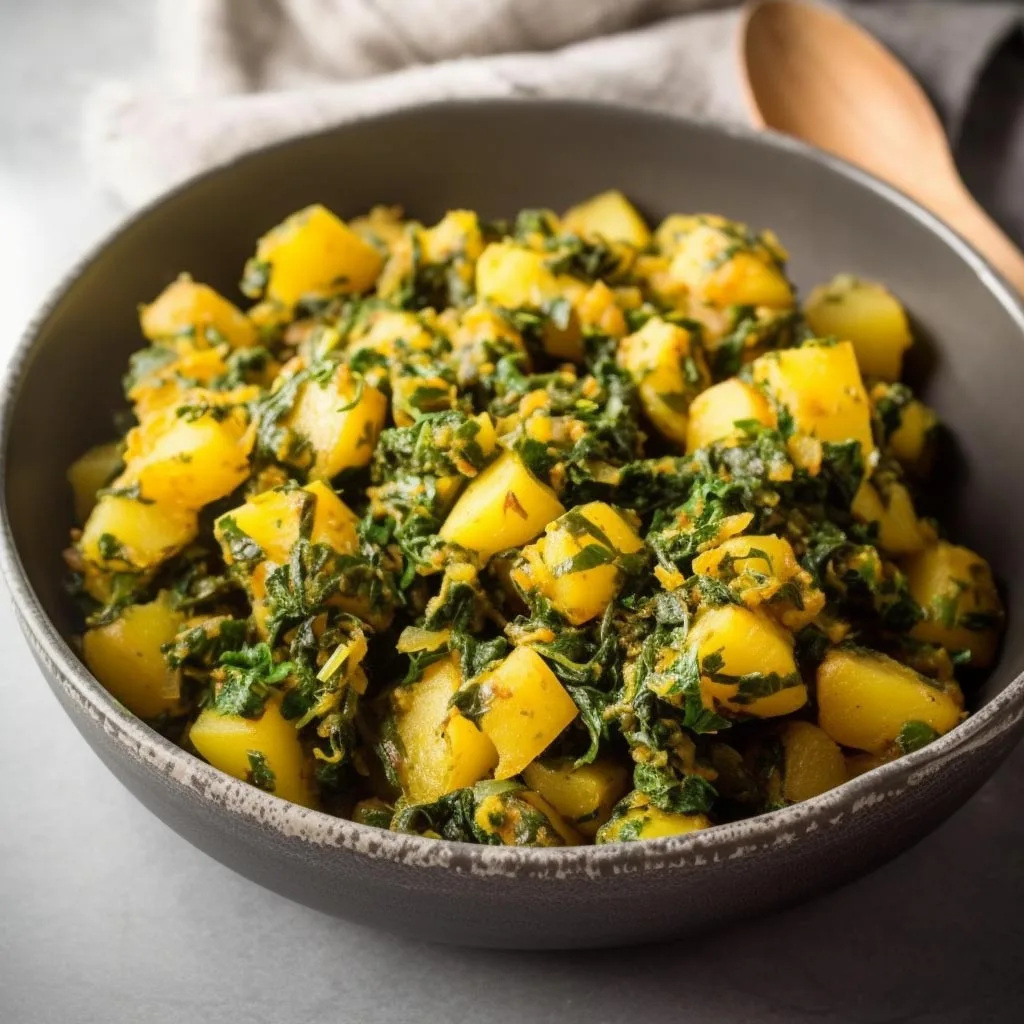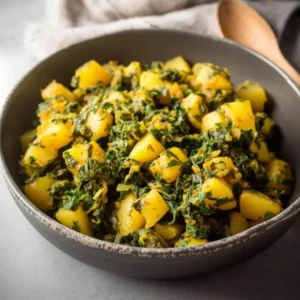
Aloo Methi, a delightful dish originating from the Indian subcontinent, brings together the earthy flavors of potatoes with the slightly bitter taste of fenugreek leaves, creating a harmonious blend that satisfies both the palate and the soul.
This recipe, while simple in its ingredients and preparation, offers a depth of flavor that belies its ease of cooking. Aloo Methi holds a cherished place in Indian cuisine, often gracing dining tables as a comforting accompaniment to chapatis or rice.
The combination of potatoes and fenugreek leaves not only provides a nutritional punch but also offers a symphony of flavors and textures.
Potatoes, diced into small cubes, contribute a hearty and creamy element to the dish, while fenugreek leaves, washed and chopped, impart a unique bitterness that balances the overall taste profile. Together, they create a dish that is both wholesome and satisfying.
While the recipe may seem daunting to beginners, its simplicity is its strength. With just a handful of ingredients and straightforward cooking techniques, anyone can master the art of making Aloo Methi.
From the crackling of cumin seeds in hot oil to the aromatic melding of spices, each step in the process adds layers of flavor, culminating in a dish that is as comforting as it is flavorful.
Expert Tip: To speed up the cooking process, parboil the diced potatoes before adding them to the pan.
Potatoes: Potatoes, peeled and diced into small cubes, serve as the hearty base of this dish, providing a creamy texture and mild sweetness that complements the other ingredients.
Fenugreek: Fenugreek leaves, washed and chopped, lend a slightly bitter yet deeply aromatic flavor to the dish, elevating its taste profile and providing a unique culinary experience.
Onion: Finely chopped onion adds a subtle sweetness and depth of flavor to the dish, enhancing its savory notes and contributing to the overall aroma.
Tomatoes: Chopped tomatoes contribute a tangy and slightly acidic element to the dish, balancing the bitterness of fenugreek leaves and adding a vibrant color.
Green Chillies: Finely chopped green chillies provide a hint of heat and freshness, infusing the dish with a subtle spicy kick that tantalizes the taste buds.
Cumin Seeds: Cumin seeds, when crackled in hot oil, release a warm and earthy aroma, serving as the aromatic foundation of the dish and enhancing its overall flavor profile.
Turmeric: Turmeric powder adds a vibrant yellow hue to the dish while imparting a subtle warmth and earthiness to the flavor.
Chilli Powder: Chilli powder adds a fiery kick to the dish, balancing the bitterness of fenugreek leaves with its spicy heat and enhancing the overall flavor profile.
Coriander Powder: Coriander powder contributes a mild citrusy and floral flavor to the dish, enhancing its aroma and adding depth to the overall taste.
Expert Tip: For a richer flavor, you can add a splash of lemon juice or amchur (dried mango powder) towards the end of cooking.
Expert Tip: Be sure to wash the fenugreek leaves thoroughly to remove any dirt or debris before chopping.
Yes, you can substitute dried fenugreek leaves for fresh ones. However, adjust the quantity according to taste as dried fenugreek leaves have a more concentrated flavor.
While potatoes and fenugreek are the traditional ingredients, you can experiment with other vegetables such as carrots, peas, or cauliflower to create your own variation of Aloo Methi.
Allow the dish to cool completely before transferring it to an airtight container. Store it in the refrigerator for up to 2-3 days. Reheat before serving.
Absolutely! This recipe is naturally vegan-friendly as it does not contain any animal products. Just ensure that the oil you use is vegan-friendly.
Yes, feel free to adjust the amount of green chillies and chilli powder according to your taste preferences. Start with less if you prefer a milder dish and add more gradually to suit your palate.
Here are some more recipes for you to enjoy! If you my recipes don’t forget to rate and leave a comment.
If you have any recipe suggestions, please do not hesitate to ask me. A great way to stay in contact with me is through Instagram, Facebook, Twitter and YouTube. Don’t forget to tag me @CookwithNabeela in your recipe photos!

Subscribe now to receive my latest recipes directly in your inbox. Stay up-to-date and never miss out!

I love to cook! I want to share with you my favourite, delicious family-friendly recipes. I want to inspire you to create fantastic food for your family every day.
Add your first comment to this post